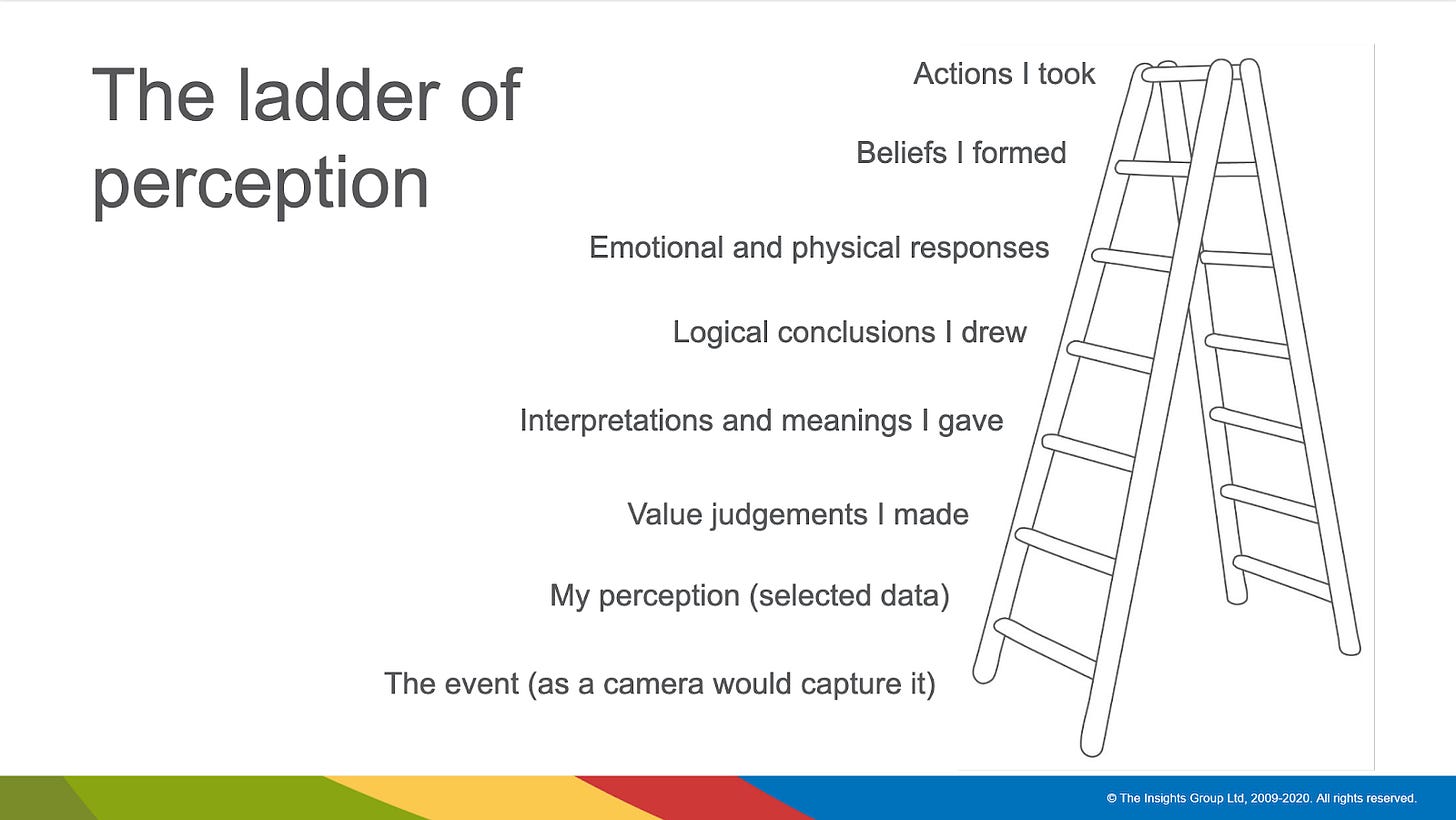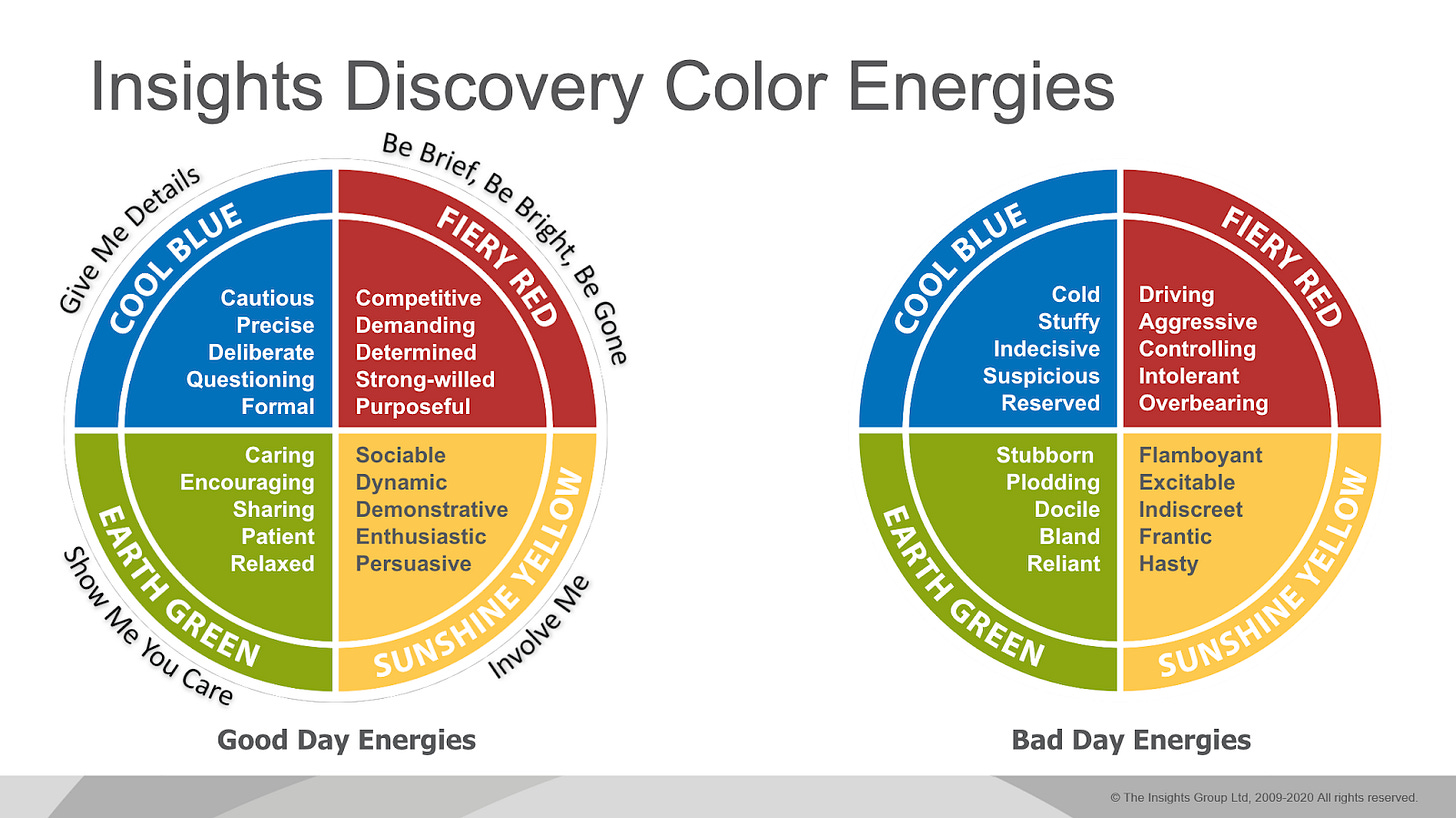The Secret to Better Communication? It’s Color-Coded.
Talk so they’ll actually listen (and understand!)
Today, we’re going to explore some of the tools I’ve acquired as part of my professional journey with Insights Discovery. You may remember me referencing Insights Discovery in various newsletters over the past several months — it’s a tool based on the philosophies of Carl Jung that helps people understand different personalities and behaviors. I’ve been using these tools for the last 10 years, and have become a licensed practitioner over the last few years. It’s helped me greatly in both my professional and personal life. I thought today we could talk through the core principles at the heart of Insights Discovery, and hopefully you can use it as a valuable tool in your life and career as well.
Perception Is Everything
So, how does understanding various personality types help us as leaders? Well, as we all know, being a leader requires a nuanced understanding of not just your organization, but of your colleagues. Especially today, when there are more generations than ever in the workforce. A 24-year-old colleague might respond to a meeting you lead in a very different way than a 52-year-old colleague, in the same way that an anxious colleague will respond to a memo in a very different way than an overly-confident colleague. Which brings me to…perception!
Perception truly is everything. Remember those old trick drawings in the back of magazines? Is it a young woman or an old witch? The way you look at a situation can color your entire understanding of it.
Every individual interprets the world through a unique lens, shaped by their experiences, cultural background, and personal values. But that doesn’t mean your perception is set in stone. Perception can change with awareness! Think about whether you saw the young lady or the old witch — you might only see one, but then you look at it from a different angle, and suddenly, you can see both. The same thing is true in the workplace. You react to a situation based on your current awareness, and have one reaction. Then a few days later, you find yourself eating crow because you learned a whole lot of information that you originally weren’t aware of.
To understand how these perceptions form, it's helpful to consider the 'Ladder of Perception.’ It illustrates how we often make assumptions and draw conclusions based on limited information, without fully considering alternative viewpoints. The floor that the ladder is resting on is the situation exactly as a camera would capture it — no opinions. Then, that first rung is how you perceived what happened based on the awareness you had. Follow the ladder up, up, up to see how you get to your actions. Your interpreted data leads you to a conclusion, which then gives you a feeling, and then, at the top of the ladder, you act.
We’ve probably all been in a situation like this: You walk into a meeting (or join it on Zoom), and your manager addresses and greets everyone by name, but they don’t acknowledge you. It’d be impossible to not draw a conclusion from that….and some of us might interpret it as a slight. You run up your ladder of perception and do something that might not reflect what your manager intended. For instance, you assume they don’t like you and you find yourself resisting their leadership for the rest of the month. They could have just missed your arrival, or they feel like they already said hi to you that morning at the coffee machine, or they just had a brain blip and didn’t mean a thing — but you’ve already taken your action at the top of the ladder, and you can’t undo it.
We have to recognize that our own perspective is just one piece of the puzzle. This is particularly crucial in leadership, where research shows there is often a huge discrepancy between how supervisors and employees perceive the same situation. But luckily, we can shift our mindset to see things from different perspectives, and be more effective leaders as a result.
What Kind of Leader Are You?
Let’s get back to Carl Jung. Insights Discovery uses Jungian principles to describe four distinct color energies that make up each of our personality and communication styles. While each of us has a combination of all four color energies, we will lead with one, or maybe two, depending on the situation.:
Those who lead with Red Energy tend to be direct, assertive, and results-oriented. They're often decisive, focused on the bottom line, and can be impatient with lengthy discussions. They value efficiency and action.
Those who lead with Blue Energy tend to be calm, analytical, and detail-oriented. They prioritize logic, accuracy, and thoroughness. They value facts and structure.
Those who lead with Yellow Energy are often enthusiastic, optimistic, and creative. They're drawn to innovation, big-picture thinking, and generating new ideas. They value inspiration and vision.
Those who lead with Green Energy are typically relational, empathetic, and focused on building connections. They prioritize harmony, collaboration, and creating a supportive environment. They value feelings and relationships.
Do any of these sound like you, or your colleagues?
There’s a full assessment tool you can take to find out exactly your blend of color energies — if you’re interested in taking it, either for yourself or for your team, just email me at steve@upvantagestrategies.com. It’s a very thorough assessment and corresponding report that will give you and your team super actionable advice on how to communicate better. You’ll be shocked at what a difference knowing your style and your team’s style can make in your day to day work life. It’s also amazing to do with your life partner. It can really unlock some obstacles in your personal communications.
Understanding these "color energies" can help you not only understand yourself better, but also understand your colleagues. It can help you:
Tailor your message: Adapt your language, tone, and approach to resonate with the other person's style.
Avoid misunderstandings: Recognize that different styles can lead to misinterpretations if you're not aware.
Build rapport: Create stronger connections by communicating in a way that feels comfortable and natural to others.
For example, when communicating with a person with lots of red color energy, you’d be wise to be concise, get to the point quickly, and focus on the results. When communicating with a person with lots of green color energy, you’ll find that you get a better outcome if you take time to build rapport, show empathy, and acknowledge their feelings.
By becoming aware of different communication styles, you can become a more adaptable and effective communicator, fostering stronger relationships and improving team collaboration.
Self-Awareness: You Think You Have It…Do You?
Central to Jungian theory is self-awareness: “Every advance, every conceptual achievement of mankind, has been connected with an advance in self-awareness.”
Self-awareness is a critical attribute of effective leaders. Understanding your strengths, weaknesses, values, and communication style enables you to build stronger relationships, make more sound decisions, and lead with authenticity.
How you relate to the world, and how you make decisions is what categorizes you on the Insights Discovery color wheel. In particular, recognizing your tendencies toward introversion or extroversion and understanding whether you make decisions from a thinking preference or a feeling preference. For instance, a leader who is more extraverted may need to consciously create opportunities for quieter team members to share their ideas. Similarly, a leader with a strong thinking preference can benefit from balancing data-driven decisions with an awareness of the emotional impact on their team.
Self-awareness is crucial for many, if not all areas of leadership, including one that is unique to our current position in history: Leading across generations. As I mentioned, there’s a bigger mix of generations at work than ever before. While this is cool (it really is!), it poses some unique challenges when it comes to leading people with not only vastly different ages, but also vastly differing perspectives on the world and work.
In today's complex world, the ability to understand diverse perspectives, bridge generational differences, and lead with self-awareness is not only smart — it’s essential. Research shows that everyone wants great leadership. But "great" can look different to different people. So how do you satisfy (and inspire) everyone? Using tools like Insights Discovery is a great way to take another step in reaching this goal.
Leadership is a never-ending journey of growth and self-discovery, and I’ve found Insights Discovery to be an absolutely critical piece of my leadership story. If you think it might be able to help you, don’t hesitate to reach out — I’d love to chat with you more about it.
I hope we introduced some new thought-provoking topics for you to consider this week. As I mentioned, gaining deeper insights into my own communication style was a game changer in my professional life, and it had some very positive effects on my personal life too. I’d love to share more from Insights Discovery with you — please reach out if you’re curious. And thanks for joining us for another reflection on leadership.
Reflection Questions
Can you recall a time when your perception of a situation led you to act in a way you later reconsidered? What could you have changed about your trip up the ‘Ladder of Perception’?
Think about someone on your team or in your life who communicates very differently from you. How might adjusting your approach based on their "color" energy improve your connection and outcomes?
Where in your leadership practice could deeper self-awareness help you bridge generational or personality-based gaps more effectively?




